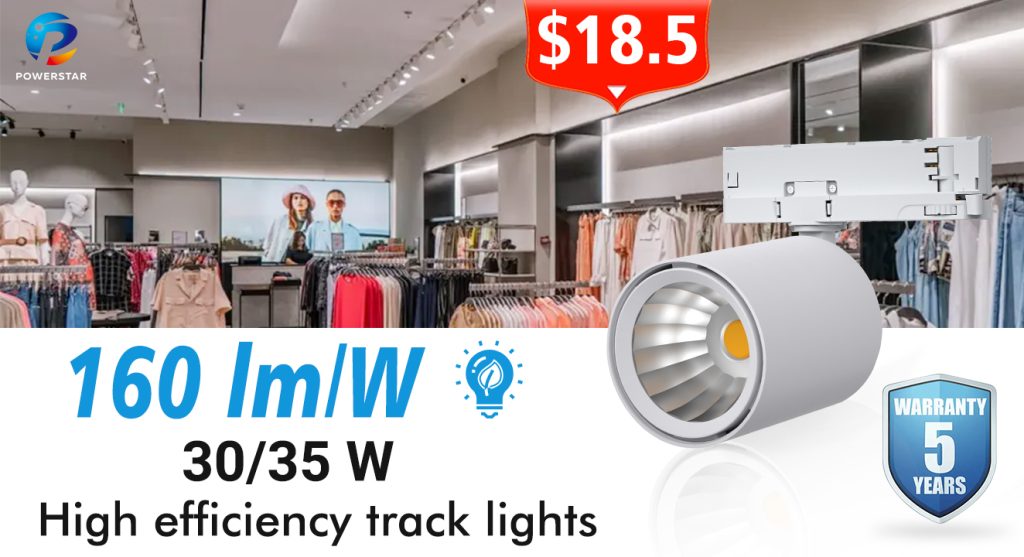160 lm/W Track Light Redefine Energy-Efficient Aesthetics
By Powerstar

160 lm/W track light you may see less. In modern commercial environments, lighting is not just a functional necessity but a critical element in experiences.
A retail chain’s case study revealed that upgrading to 160 lm/W track lights decreased annual per-store operational costs by 37%, with a payback period shortened to 1.8 years.

With breakthroughs in LED technology, the efficacy of track lights has reached an industry-leading 160 lm/W. This technical milestone is driving multidimensional value upgrades for commercial spaces, from energy savings to spatial aesthetics, redefining the future of commercial illumination.
An Energy Efficiency Revolution for Sustainable Commerce
In traditional commercial lighting systems, track lights often account for 15%-25% of operational energy costs.
For a 2,000㎡ commercial exhibition hall, upgrading to 160 lm/W track lights can reduce annual electricity consumption by approximately 35,000 kWh, equivalent to cutting 28 tons of CO₂ emissions.
Such significant energy savings enhance competitiveness for commercial spaces pursuing green certifications like LEED or BREEAM.
Amplifying Economic Returns
A retail chain’s case study revealed that upgrading to 160 lm/W track lights decreased annual per-store operational costs by 37%, with a payback period shortened to 1.8 years. This economic model proves ideal for 24/7 operations like hotels and malls, optimizing cost structures while elevating lighting quality.
Optical Excellence Meets Design Flexibility
High efficacy does not compromise optical performance. Utilizing micro-prism reflection technology and precision light distribution, these track lights achieve Ra>90 Color Rendering Index (CRI), boosting product color accuracy by 22%—a critical advantage for jewelry and apparel retail. Ultra-slim modules (≤35mm thickness) grant designers unparalleled freedom, enabling museum-grade accent lighting or seamless ambient illumination.
A Shanghai luxury mall renovation demonstrated that 160 lm/W track lights enhanced spatial visual hierarchy by 40%, increasing customer dwell time by 18%.
Smart Integration: Building Future-Ready Ecosystems
The 160 lm/W platform provides a stable foundation for intelligent controls. Compatible with DALI 2.0 or Zigbee 3.0 protocols, these systems enable 0.1% dimming precision and occupancy-adaptive lighting. With a baseline efficacy of 160 lm/W, smart dimming unlocks an additional 30% energy-saving potential. A smart office building case showed that integrating 160 lm/W track lights with occupancy sensors achieved 76% total energy savings and a 27% boost in employee satisfaction.
Aligning with ESG Values
Amid growing ESG (Environmental, Social, Governance) priorities, 160 lm/W track lights serve as tangible symbols of corporate sustainability. Their production incorporates 75% recycled aluminum, with a 58% lower lifecycle carbon footprint versus traditional fixtures. In commercial spaces lit by 160 lm/W systems, 4000K neutral white light and visible energy efficiency labels create eco-conscious consumer experiences. Surveys indicate 67% of Generation Z shoppers prefer venues explicitly showcasing lighting efficacy ratings.

The 160 lm/W benchmark marks a transformative shift in commercial lighting—from functional hardware to a value-driven medium. It represents both a rational choice for cost efficiency and an emotional conduit for sustainability.
When every beam of light carries the DNA of 160 lumens per watt, commercial spaces gain illumination solutions that harmonize economics and humanity. This synergy between technological innovation and commercial needs is redefining the competitive edge of physical retail environments.


